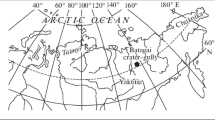Abstract
This paper reports on the oxygen isotope composition of the Late Pleistocene and Holocene syngenetic ice wedges, which were exposed at Mamontova Gora and Syrdakh Lake, the Accelerator Mass Spectrometry dating, and the reconstruction of the winter air temperatures during ice wedge formation. Organic microinclusions from the ice wedges were directly dated, which allowed us to establish seven dates ranging from 13 to 19 ka BP. The age of the ice wedges is shown to be younger than 20 ka, but older than 10 ka BP. In the area of Mamontova Gora, δ18O is in the range of –24.7 to –30.9‰ for the Late Pleistocene ice wedges, and of –23.2 to –25.9‰ for the Holocene ice wedges. In the area of Syrdakh Lake, δ18O ranges from –29.2 to –32.5‰. At the Mamontova Gora site, the average winter air temperatures, which were reconstructed from the isotope data, ranged from –28 to –31°C during most of the period when the Late Pleistocene ice wedges were formed; the January temperature was –42°C, –46°C. At the Syrdakh Lake site, the Late Pleistocene winter conditions were more severe: the average winter air temperature ranged from –30 to –32°C, and the average January air temperature was –44, –48°C. In the Holocene, the average winter air temperatures were higher and ranged from –24 to –28°C, while the average January temperatures ranged from –36 to –42°C.




Similar content being viewed by others
REFERENCES
Section of the Newest Deposits Mamontova Gora, Ed. by K. K. Markov (Moscow State Univ., Moscow, 1973) [in Russian].
T. L. Pewe and A. Journaux, Geol. Surv. Prof. Pap. (U. S.), No. 1262, 1–46 (1983).
Yu. K. Vasil’chuk, Trans. (Dokl.) USSR Acad. Sci. Earth Sci. Sect. 298, 56–59 (1988).
Yu. K. Vasil’chuk, J.-C. Kim, and A. C. Vasil’chuk, Nucl. Instrum. Methods Phys. Res., Sect. B 223–224, 650–654 (2004).
Yu. K. Vasil’chuk and A. C. Vasil’chuk, GeoResJ 13, 83–95 (2017).
S. Popp, B. Diekmann, H. Meyer, C. Siegert, I. Syromyatnikov, and H. Hubberten, Permafrost Periglacial Processes 17, 119–132 (2006).
Yu. K. Vasil’chuk, Wat. Resour. 17 (6), 640–647 (1991).
ACKNOWLEDGMENTS
The authors are grateful to Ju.N. Chizhova for help in the isotope studies.
Funding
The authors have received the financial support of the Russian Foundation for Basic Research (project no. 16-35-00403—field work, no. 17-05-00793—geochemical analyses, no. 17-05-00794—paleotemperature studies), the isotope studies were supported by the Russian Science Foundation, project no. 14-27-00083.
Author information
Authors and Affiliations
Corresponding author
Additional information
Translated by V. Krutikova
Rights and permissions
About this article
Cite this article
Vasil’chuk, Y.K., Shmelev, D.G., Cherbunina, M.Y. et al. New Oxygen Isotope Diagrams of Late Pleistocene and Holocene Ice Wedges in Mamontova Gora and Syrdakh Lake, Central Yakutia. Dokl. Earth Sc. 486, 580–584 (2019). https://doi.org/10.1134/S1028334X19050283
Received:
Published:
Issue Date:
DOI: https://doi.org/10.1134/S1028334X19050283




